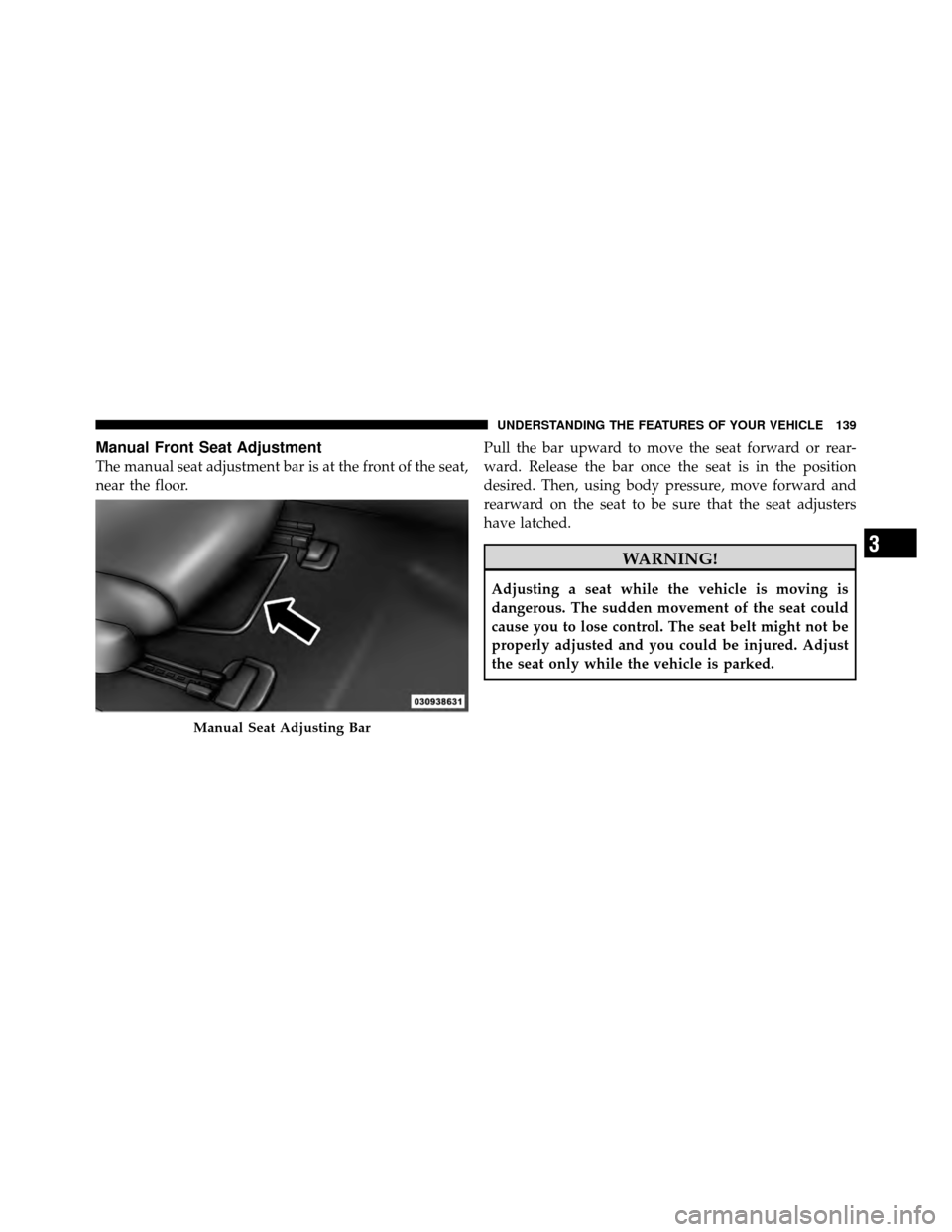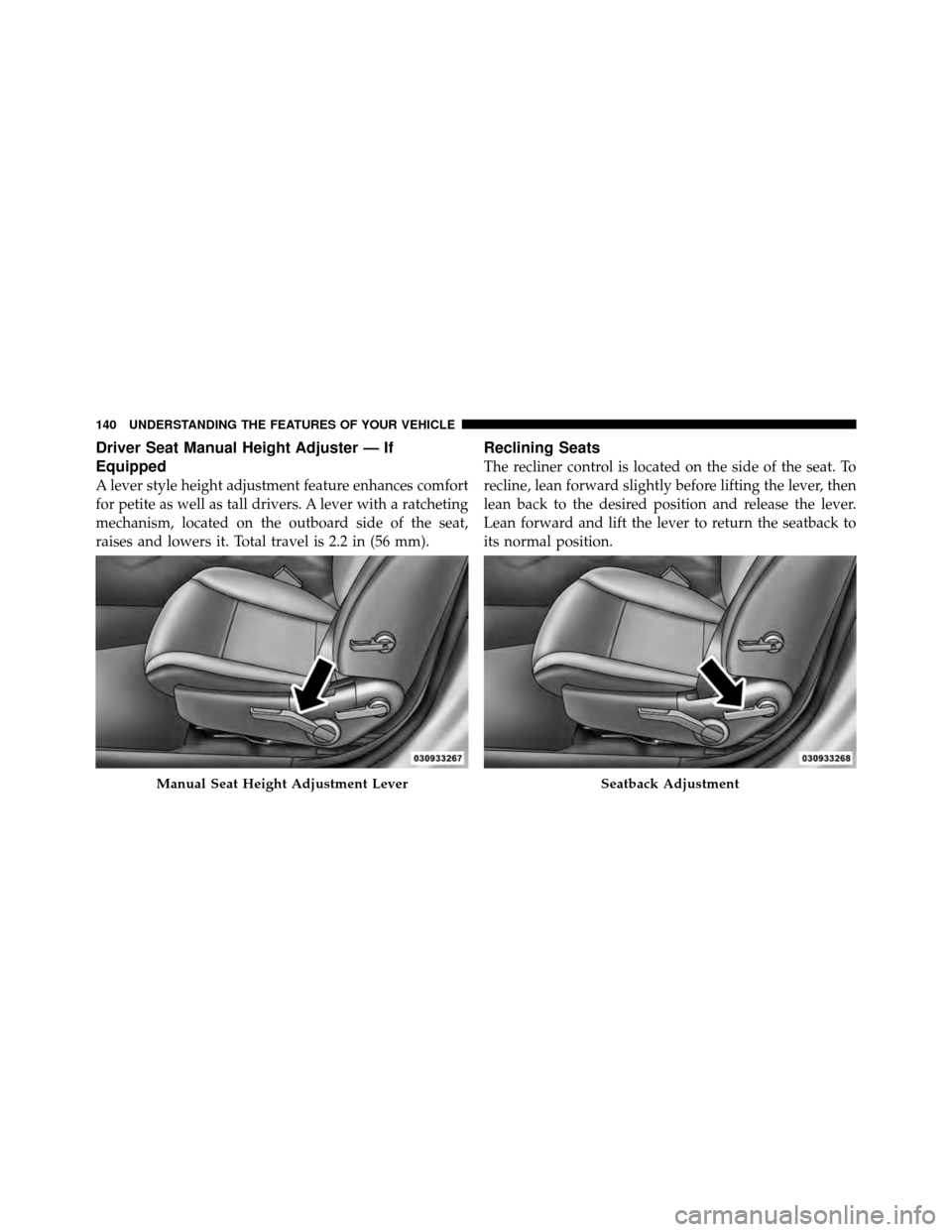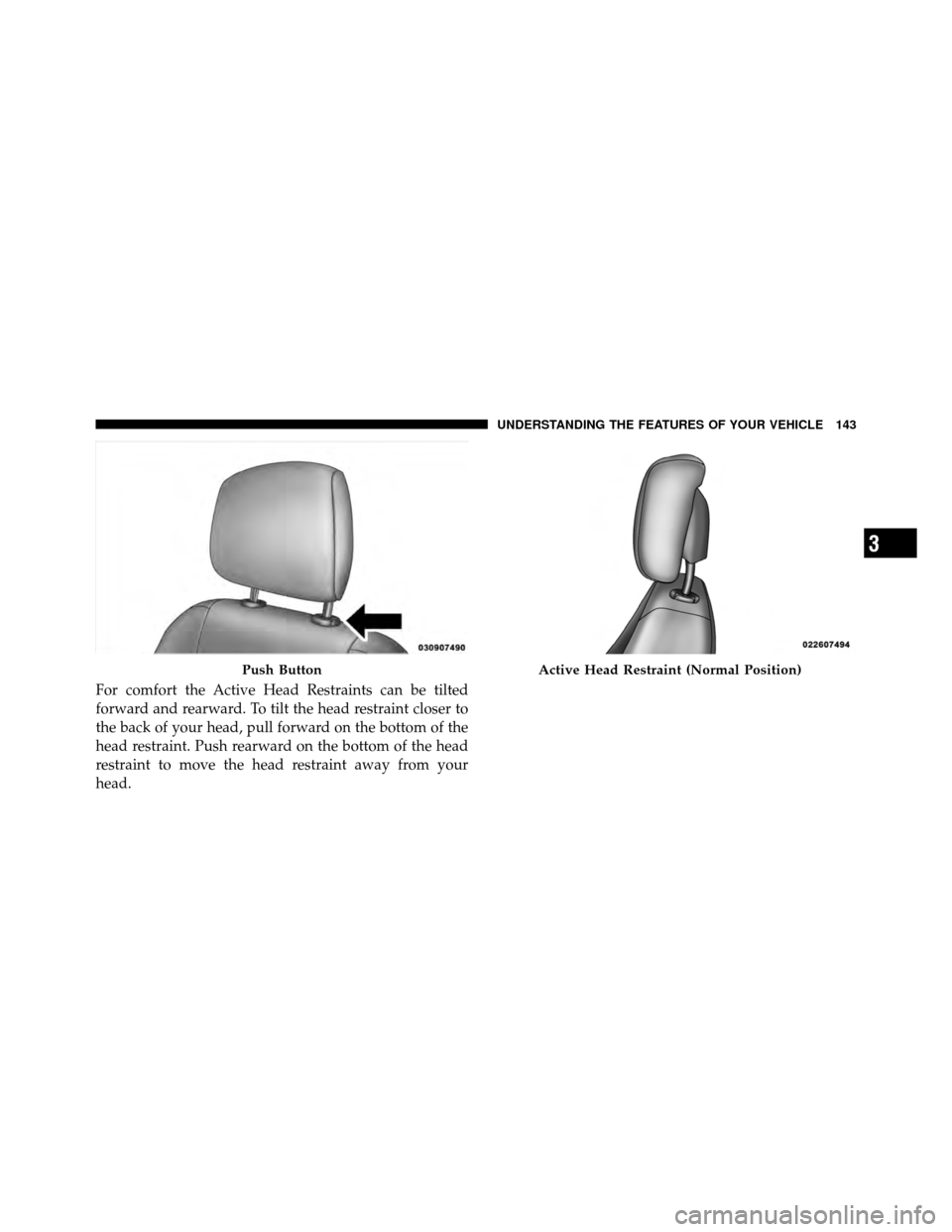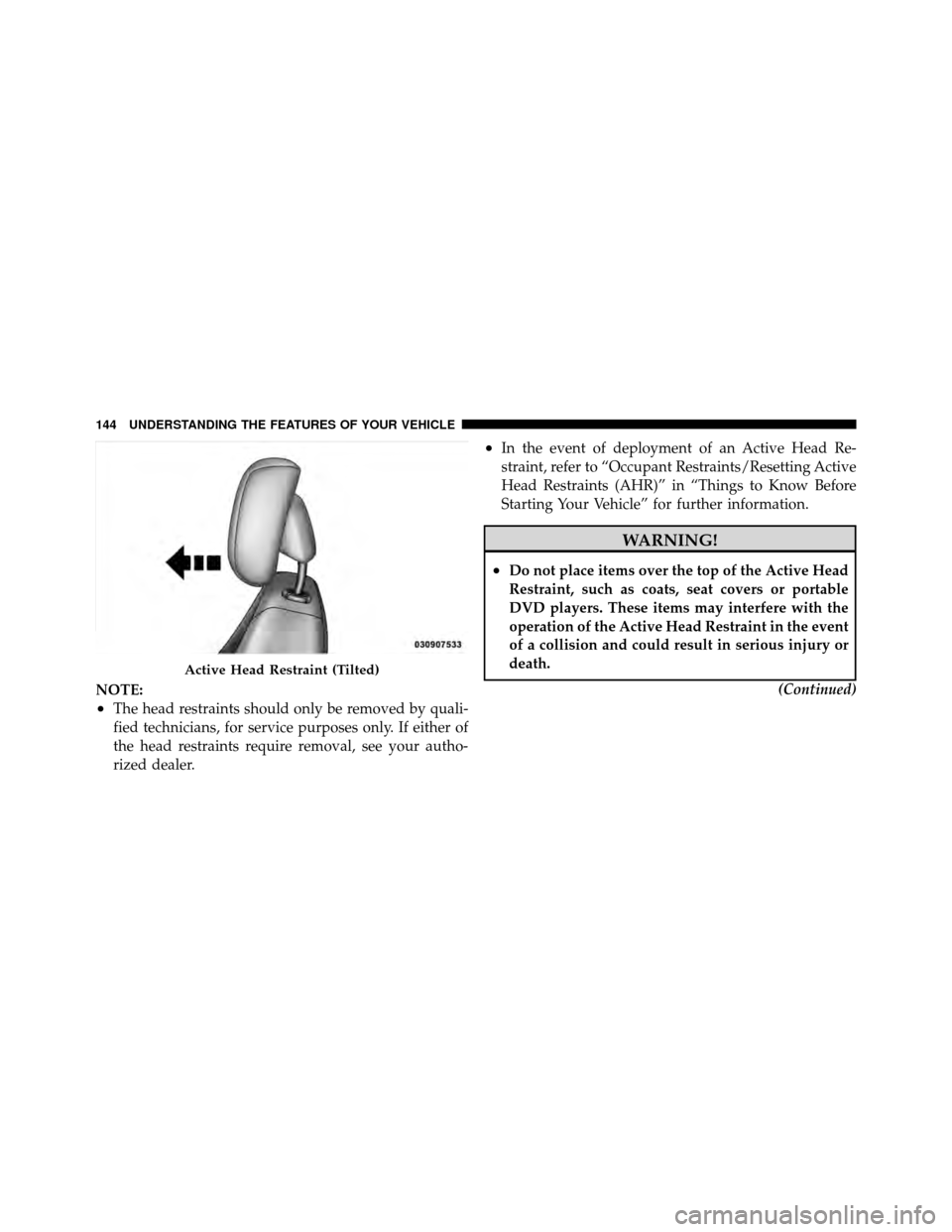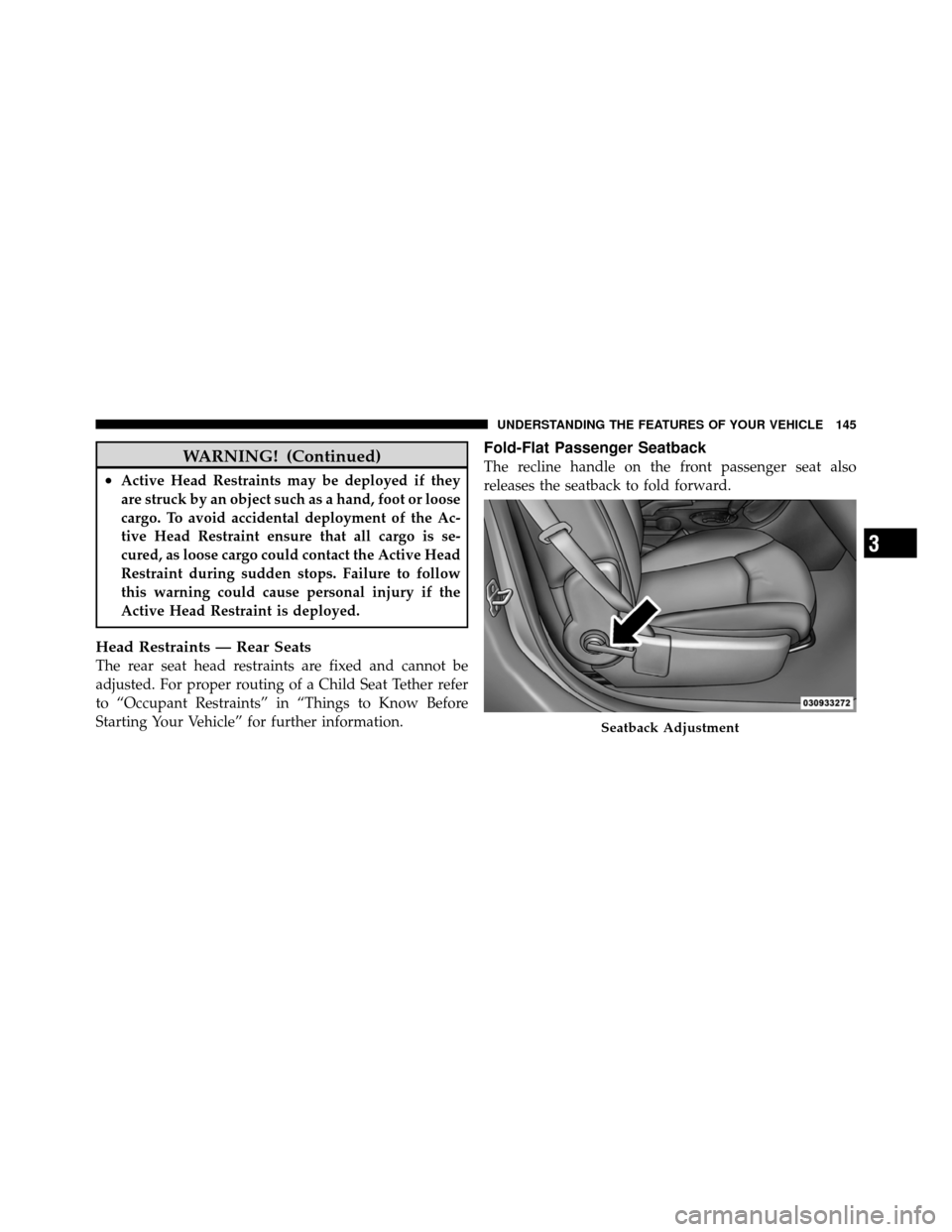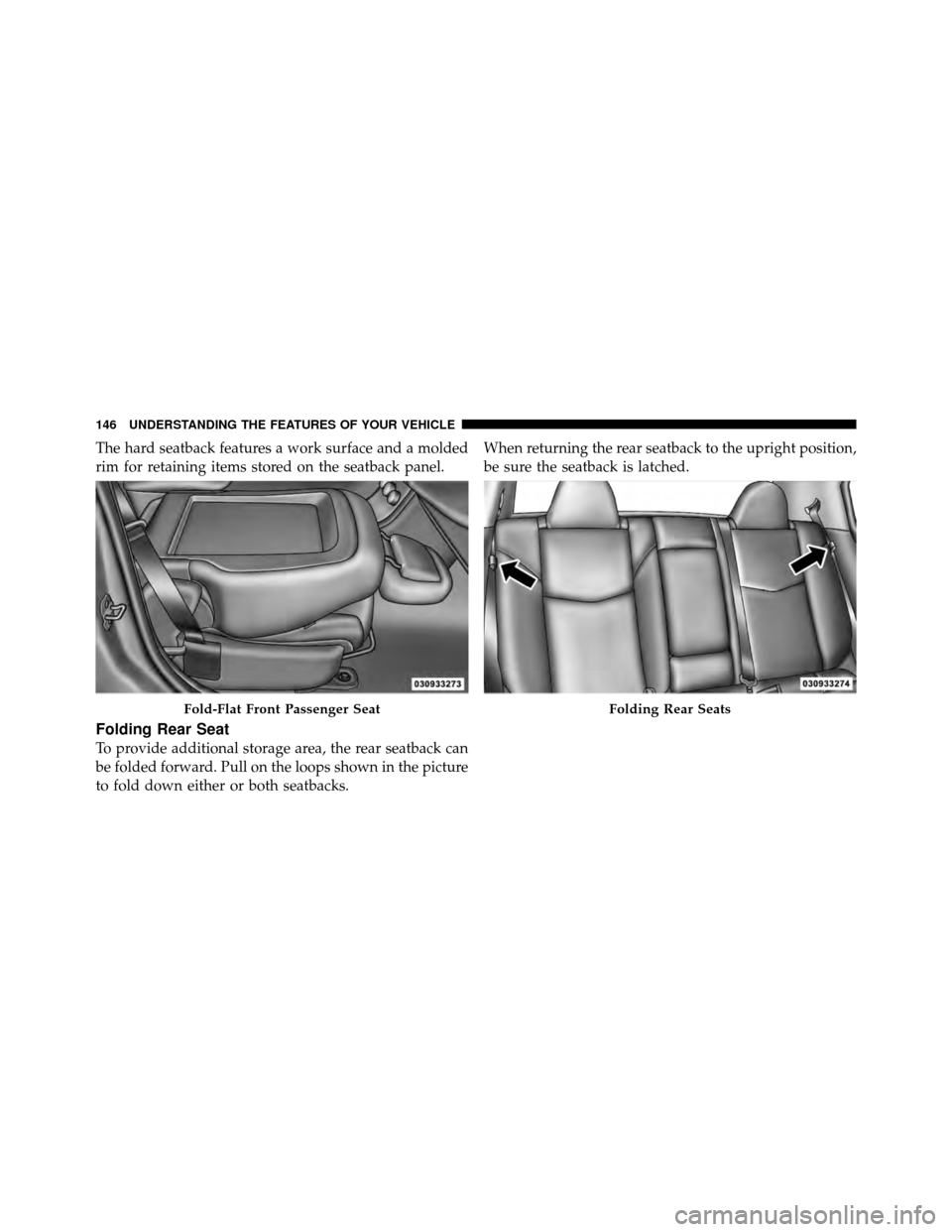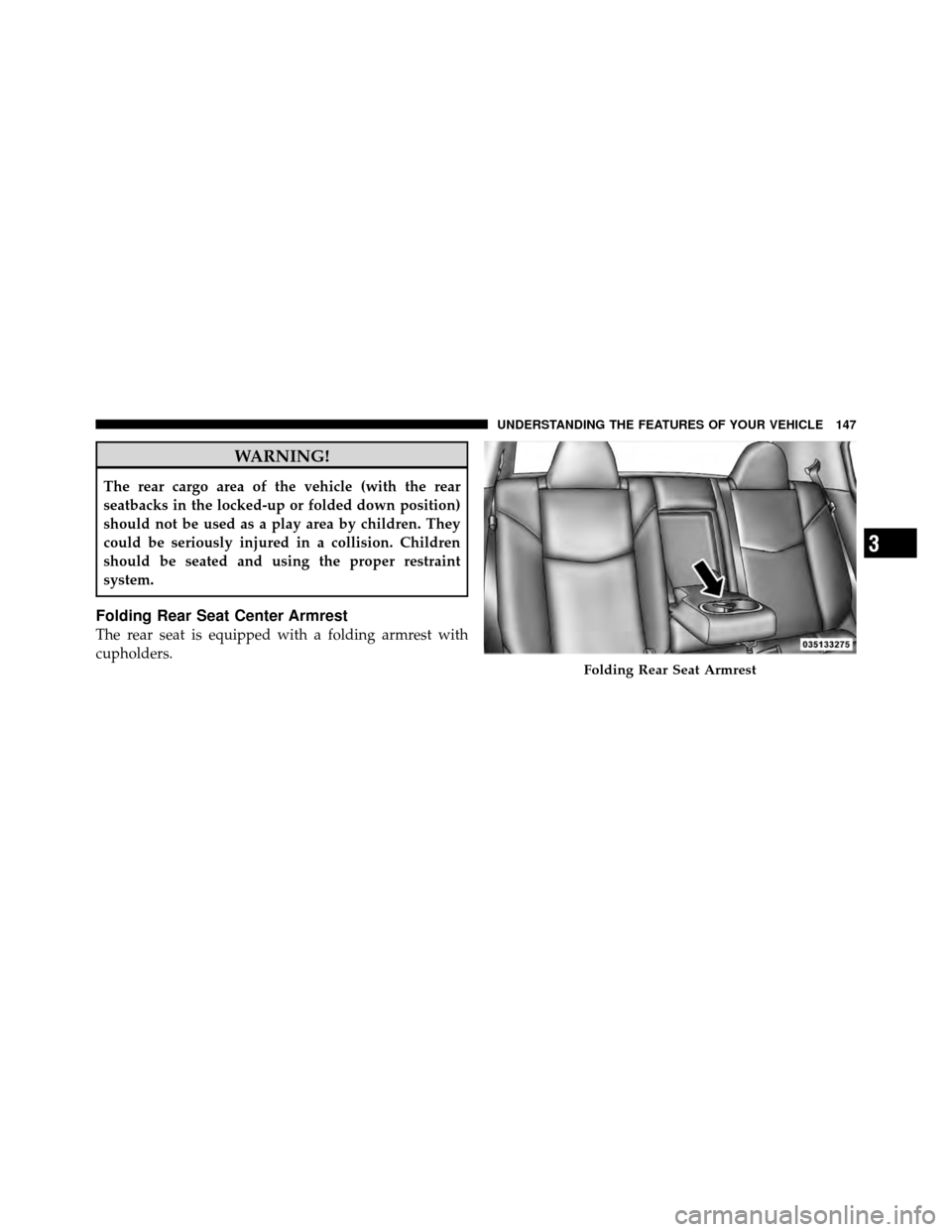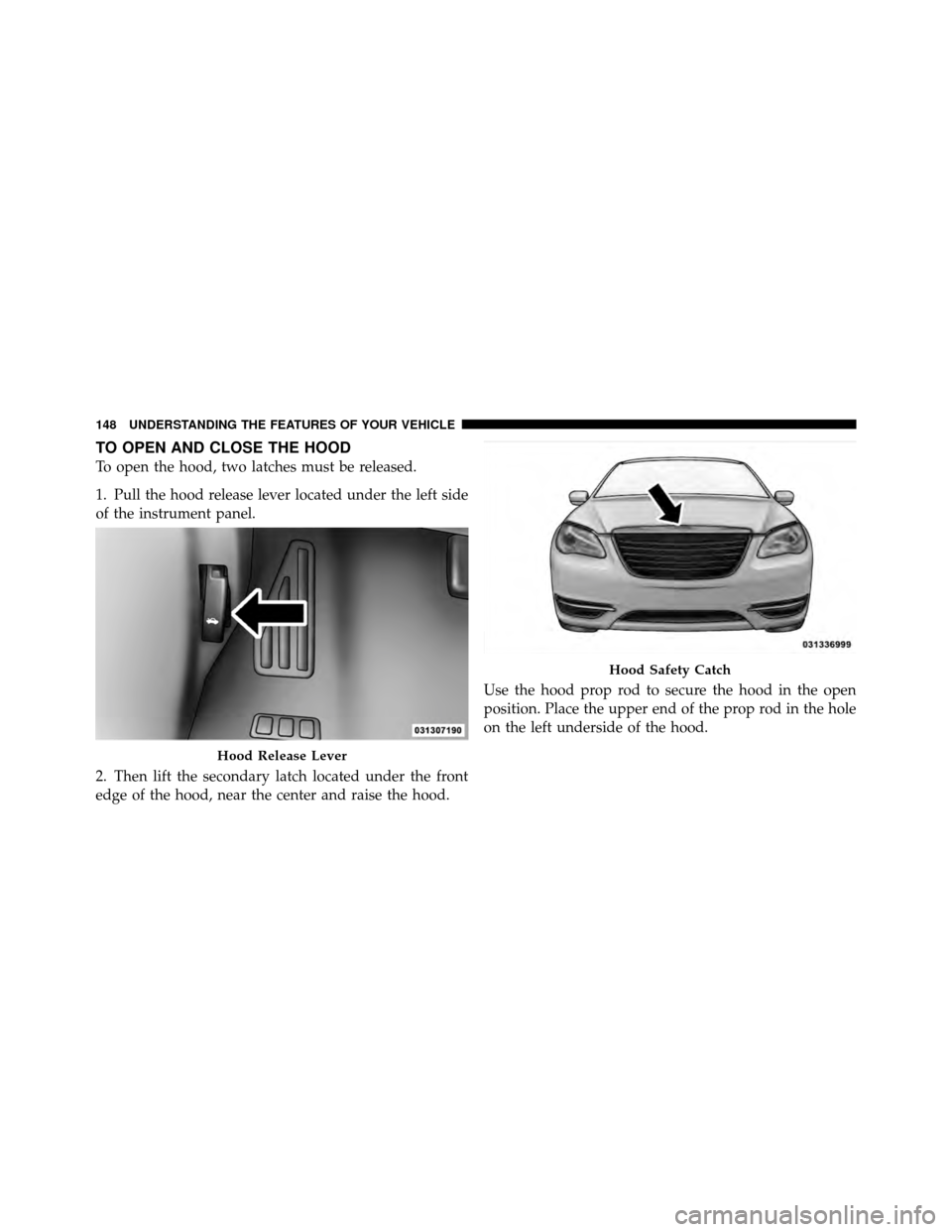CHRYSLER 200 2012 1.G Owners Manual
200 2012 1.G
CHRYSLER
CHRYSLER
https://www.carmanualsonline.info/img/25/8394/w960_8394-0.png
CHRYSLER 200 2012 1.G Owners Manual
Trending: Engine, relay, washer fluid, check engine, service indicator, turn signal bulb, engine oil capacity
Page 141 of 508
Manual Front Seat Adjustment
The manual seat adjustment bar is at the front of the seat,
near the floor.Pull the bar upward to move the seat forward or rear-
ward. Release the bar once the seat is in the position
desired. Then, using body pressure, move forward and
rearward on the seat to be sure that the seat adjusters
have latched.
WARNING!
Adjusting a seat while the vehicle is moving is
dangerous. The sudden movement of the seat could
cause you to lose control. The seat belt might not be
properly adjusted and you could be injured. Adjust
the seat only while the vehicle is parked.
Manual Seat Adjusting Bar
3
UNDERSTANDING THE FEATURES OF YOUR VEHICLE 139
Page 142 of 508
Driver Seat Manual Height Adjuster — If
Equipped
A lever style height adjustment feature enhances comfort
for petite as well as tall drivers. A lever with a ratcheting
mechanism, located on the outboard side of the seat,
raises and lowers it. Total travel is 2.2 in (56 mm).
Reclining Seats
The recliner control is located on the side of the seat. To
recline, lean forward slightly before lifting the lever, then
lean back to the desired position and release the lever.
Lean forward and lift the lever to return the seatback to
its normal position.
Manual Seat Height Adjustment LeverSeatback Adjustment
140 UNDERSTANDING THE FEATURES OF YOUR VEHICLE
Page 143 of 508
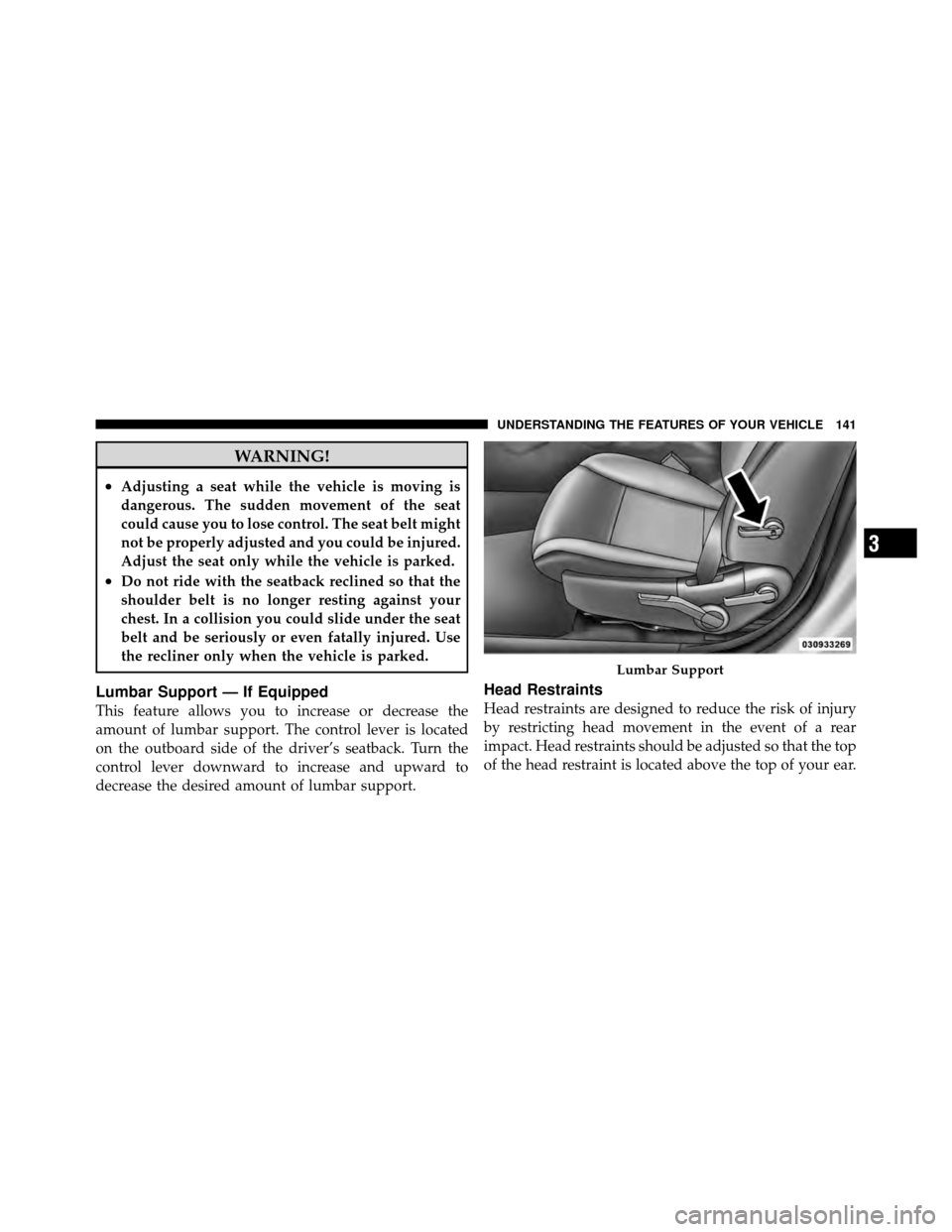
WARNING!
•Adjusting a seat while the vehicle is moving is
dangerous. The sudden movement of the seat
could cause you to lose control. The seat belt might
not be properly adjusted and you could be injured.
Adjust the seat only while the vehicle is parked.
•Do not ride with the seatback reclined so that the
shoulder belt is no longer resting against your
chest. In a collision you could slide under the seat
belt and be seriously or even fatally injured. Use
the recliner only when the vehicle is parked.
Lumbar Support — If Equipped
This feature allows you to increase or decrease the
amount of lumbar support. The control lever is located
on the outboard side of the driver’s seatback. Turn the
control lever downward to increase and upward to
decrease the desired amount of lumbar support.
Head Restraints
Head restraints are designed to reduce the risk of injury
by restricting head movement in the event of a rear
impact. Head restraints should be adjusted so that the top
of the head restraint is located above the top of your ear.
Lumbar Support
3
UNDERSTANDING THE FEATURES OF YOUR VEHICLE 141
Page 144 of 508
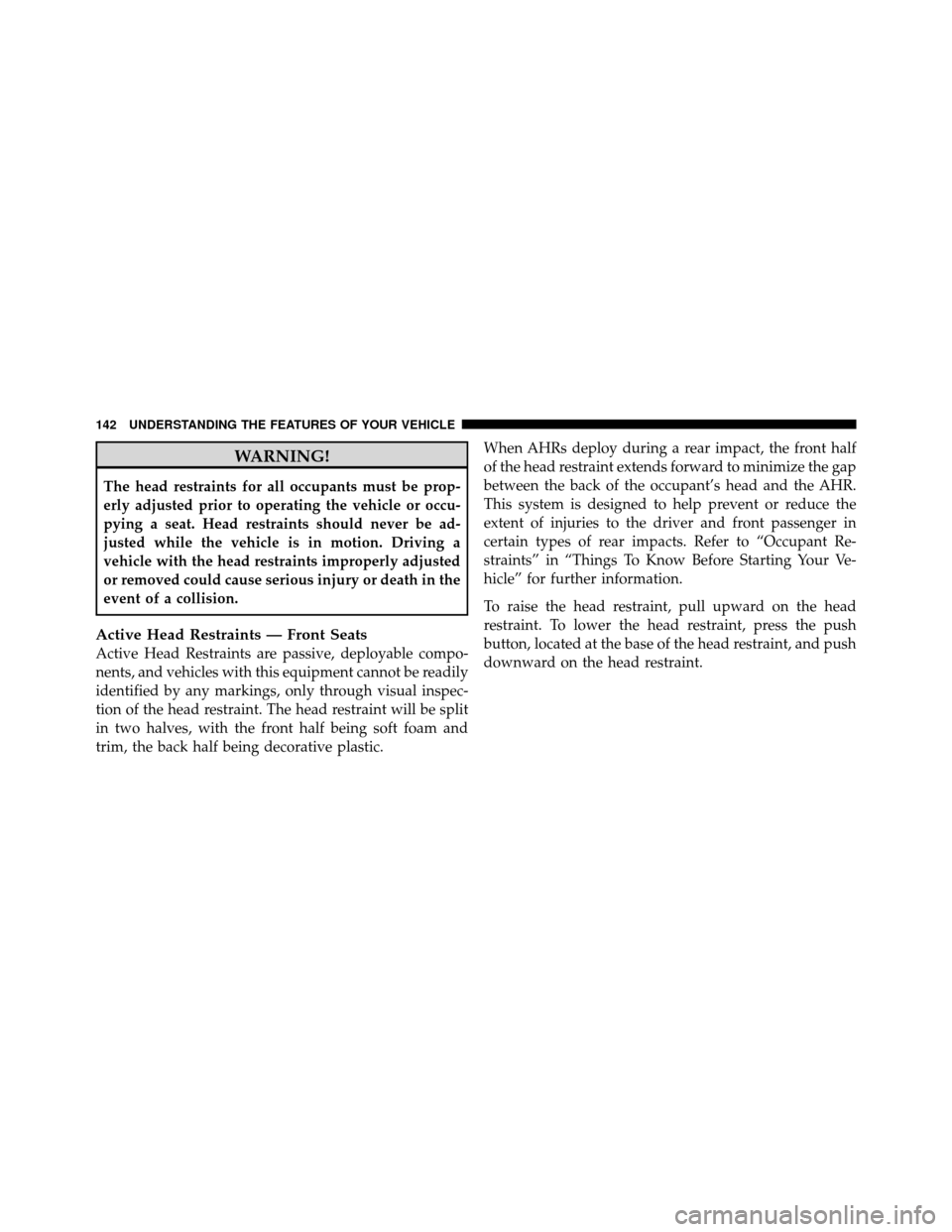
WARNING!
The head restraints for all occupants must be prop-
erly adjusted prior to operating the vehicle or occu-
pying a seat. Head restraints should never be ad-
justed while the vehicle is in motion. Driving a
vehicle with the head restraints improperly adjusted
or removed could cause serious injury or death in the
event of a collision.
Active Head Restraints — Front Seats
Active Head Restraints are passive, deployable compo-
nents, and vehicles with this equipment cannot be readily
identified by any markings, only through visual inspec-
tion of the head restraint. The head restraint will be split
in two halves, with the front half being soft foam and
trim, the back half being decorative plastic.When AHRs deploy during a rear impact, the front half
of the head restraint extends forward to minimize the gap
between the back of the occupant’s head and the AHR.
This system is designed to help prevent or reduce the
extent of injuries to the driver and front passenger in
certain types of rear impacts. Refer to “Occupant Re-
straints” in “Things To Know Before Starting Your Ve-
hicle” for further information.
To raise the head restraint, pull upward on the head
restraint. To lower the head restraint, press the push
button, located at the base of the head restraint, and push
downward on the head restraint.
142 UNDERSTANDING THE FEATURES OF YOUR VEHICLE
Page 145 of 508
For comfort the Active Head Restraints can be tilted
forward and rearward. To tilt the head restraint closer to
the back of your head, pull forward on the bottom of the
head restraint. Push rearward on the bottom of the head
restraint to move the head restraint away from your
head.
Push ButtonActive Head Restraint (Normal Position)
3
UNDERSTANDING THE FEATURES OF YOUR VEHICLE 143
Page 146 of 508
NOTE:
•The head restraints should only be removed by quali-
fied technicians, for service purposes only. If either of
the head restraints require removal, see your autho-
rized dealer.
•In the event of deployment of an Active Head Re-
straint, refer to “Occupant Restraints/Resetting Active
Head Restraints (AHR)” in “Things to Know Before
Starting Your Vehicle” for further information.
WARNING!
•Do not place items over the top of the Active Head
Restraint, such as coats, seat covers or portable
DVD players. These items may interfere with the
operation of the Active Head Restraint in the event
of a collision and could result in serious injury or
death.(Continued)
Active Head Restraint (Tilted)
144 UNDERSTANDING THE FEATURES OF YOUR VEHICLE
Page 147 of 508
WARNING! (Continued)
•Active Head Restraints may be deployed if they
are struck by an object such as a hand, foot or loose
cargo. To avoid accidental deployment of the Ac-
tive Head Restraint ensure that all cargo is se-
cured, as loose cargo could contact the Active Head
Restraint during sudden stops. Failure to follow
this warning could cause personal injury if the
Active Head Restraint is deployed.
Head Restraints — Rear Seats
The rear seat head restraints are fixed and cannot be
adjusted. For proper routing of a Child Seat Tether refer
to “Occupant Restraints” in “Things to Know Before
Starting Your Vehicle” for further information.
Fold-Flat Passenger Seatback
The recline handle on the front passenger seat also
releases the seatback to fold forward.
Seatback Adjustment
3
UNDERSTANDING THE FEATURES OF YOUR VEHICLE 145
Page 148 of 508
The hard seatback features a work surface and a molded
rim for retaining items stored on the seatback panel.
Folding Rear Seat
To provide additional storage area, the rear seatback can
be folded forward. Pull on the loops shown in the picture
to fold down either or both seatbacks.When returning the rear seatback to the upright position,
be sure the seatback is latched.
Fold-Flat Front Passenger SeatFolding Rear Seats
146 UNDERSTANDING THE FEATURES OF YOUR VEHICLE
Page 149 of 508
WARNING!
The rear cargo area of the vehicle (with the rear
seatbacks in the locked-up or folded down position)
should not be used as a play area by children. They
could be seriously injured in a collision. Children
should be seated and using the proper restraint
system.
Folding Rear Seat Center Armrest
The rear seat is equipped with a folding armrest with
cupholders.
Folding Rear Seat Armrest
3
UNDERSTANDING THE FEATURES OF YOUR VEHICLE 147
Page 150 of 508
TO OPEN AND CLOSE THE HOOD
To open the hood, two latches must be released.
1. Pull the hood release lever located under the left side
of the instrument panel.
2. Then lift the secondary latch located under the front
edge of the hood, near the center and raise the hood.Use the hood prop rod to secure the hood in the open
position. Place the upper end of the prop rod in the hole
on the left underside of the hood.
Hood Release Lever
Hood Safety Catch
148 UNDERSTANDING THE FEATURES OF YOUR VEHICLE
Trending: climate control, child restraint, coolant temperature, fog light, winter tires, jump start terminals, key fob
